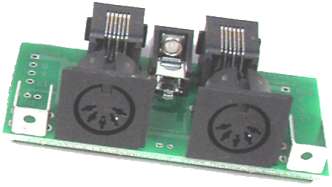NCE makes the following endorsement of their
UTP-DIN cab
panel:
"Recommended for large club installations. This panel
combines low cost with rugged DIN jacks for long life."

This product installs on the fascia on the front edge of the
layout, for plugging your Cab (throttle) into and connecting to
the layout.
Before NCE made this product, APN designed a very similar
device based on wiring information in the Wangrow SystemOne
Manual. These "homemade" jacks are what is in use on our
layout.
With NCE's introduction of their own version of this type of
panel, they also now offer a throttle cable with a DIN plug,
however they
do not ship this cable with their Cabs. They do offer one for sale as an
accessory, their "Coilcord-DIN". part number
524-210.
The downsides of using the NCE part:
- the RJ11 plug end will need to be replaced and reversed
(someone at the club can help you with this) to make it
compatible with our jacks
- it has a 90° plug that will point
upward when plugged into our throttle jacks
- it is only 7' long (this is usually
adequate, but the cables most members use are 10' in length)
As an alternative to buying this DIN plug equipped NCE cord,
(which are not stocked by all local hobby shops), you
can opt to build your own using this article. If you are
uncomfortable with building your own, check with a member of the
electrical committee. From time to time they take orders
to build cables as a convenience to members. From time to
time, the committee also makes up a small inventory of cables,
and these can be purchased from the Club.
NOTE:
The choice of coiled
cord used is of importance as there are some types of cables that have wire that is
next to impossible to solder to. We have not had that problem using
the part numbers shown below. Substitute other makes of cord at your
own risk.
Remember to slip the rubber/vinyl
boot over the cable before soldering to the plug!
| 
